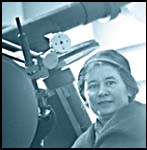



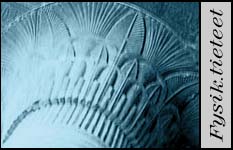
WOMEN OF LEARNING: NAME INDEX | DISCIPLINES | PERIODS | FIRSTS | THE INVISIBLE
LANDMARKS | FACTS | WOMEN'S STUDIES | FRONT PAGE

 |
TUIJA PULKKINEN space scientist 1962- |
||
What is space weather like today? The solar wind, or the particle flow radiated towards us by the Sun, gives rise to this question as it collides with Earth's magnetosphere. Geomagnetic storms can cause various phenomena, of which the aurora are most familiar to us. They occur in the ionosphere of the Earth at a height of 80-300 kilometers. Tuija Pulkkinen at the Finnish Meteorological Institute has studied auroral storms and their connection to near space phenomena since 1980s. Despite her youth, she has already advanced a long way in her research career. Pulkkinen says that she wanted to choose an area of research that was not purely theoretical, but in which she could make observations and develop the theory further. Because of its geographical location at the equatorward edge of the auroral zone, Finland is well suited for the study of aurora. The magnetic field of the Earth and its changes have already been monitored since the early 19th century. A comprehensive network of measuring instruments has been built all over Finland and Scandinavia. From the 1980s on, it has also become possible to place instruments in space satellites that orbit the Earth. Finns have a good reputation as designers of such instrumentation. Tuija Pulkkinen (née Mali) was considering future studies either in Finnish or in natural sciences while in school. She didn't, however, want to become a teacher of Finnish, and thus she chose physics instead. The gifted young woman made rapid academic progress. She completed her Master's degree in just five years. In 1992, she became the first Finnish woman to complete a Ph.D. degree in theoretical physics. The topic of her dissertation was Magnetic field modeling during dynamic magnetospheric processes. In her research for the doctoral dissertation, Pulkkinen developed a method for modeling the near space magnetic field. She has applied this model to auroral storms. Earth's magnetic field has a 'tail' pointing away from the direction from where the solar wind is arriving (i.e., away from the Sun). Pulkkinen started with the electric current systems prior to auroral storms, and later also included the recovery phase current systems in her model. In this way, it becomes possible to find out the causal relationships between the electric current systems of the tail of the magnetic field, and the observed aurora. Researchers at the Finnish Meteorological Institute have also developed a magnetohydrodynamic simulation model. With it, it is possible to simulate phenomena occurring in connection of auroral storms solely on basis of what kind of solar wind the Sun is emitting. In other words, it is like a space weather forecast. The results of this simulation model are compared with observations, e.g., ground based or satellite photographs of the aurora and with the magnetic field models developed by Pulkkinen. The simulation code used at the Finnish Meteorological Institute is unique in Europe. Other codes are in use in the U.S.A. and in Japan. Pulkkinen is also familiar with these, as she has worked with American research groups involved with modeling. The research projects in which Tuija Pulkkinen is a participant are quite international, which makes daily contacts to various parts of the world a necessity. She is a research professor at the Finnish Meteorological Institute. Among the current challenges for Pulkkinen and the space plasma physics group at the Finnish Meteorological Institute is the idea of establishing a European space weather program. Apart from basic research, its activities would include space weather forecasts. Particle eruptions taking place in space can damage satellites, and correct weather forecasts can help to avoid this damage. Space weather also affects transcontinental telephone traffic and transmissions of satellite tv channels. Its ground based effects include damage to transformers of power transmission lines, and the intensified corrosion of long gas pipelines. Tuija Pulkkinen's research has received well-deserved recognition. In 1998, she was the Macelwane medalist of the American Geophysical Union. The medal is given to a promising young researcher in the field of geophysics. In 1999, Pulkkinen received the science prize of the City of Helsinki. The workdays of a research scientist can be long, and one must travel often. The mother of one has to balance work and family life. However, Tuija Pulkkinen calls her family one of her main resources. Eva Isaksson  1 1
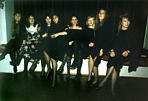 2 2
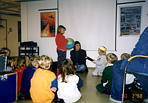 3 3
 4 4
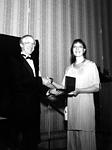 5 5
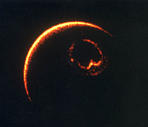 6 6
1 Public defense of dissertation 1992. Georg Gustafsson from Uppsala University as opponent. 2 Finnish women physicists at the party after Tuija Pulkkinen's public defense of her dissertation. 3 Tuija Pulkkinen is talking to visiting children from a day care centre at the Finnish Meteological Institute about the Sun and solar wind, using a torch and a hairdryer to demonstrate. 4,5 In 1998, Tuija Pulkkinen received the Macelwane medal of the American Geophysical Union in Boston. The medal is given to a promising young researcher in the field of geophysics. 6 Tuija Pulkkinen's favourite aurora: a heart-shaped aurora, with the Earth seen in the background. Photos: Tuija Pulkkinen More information: Tuija Pulkkinen's homepage "Pulkkinen Receives James B. Macelwane Medal". |
|||